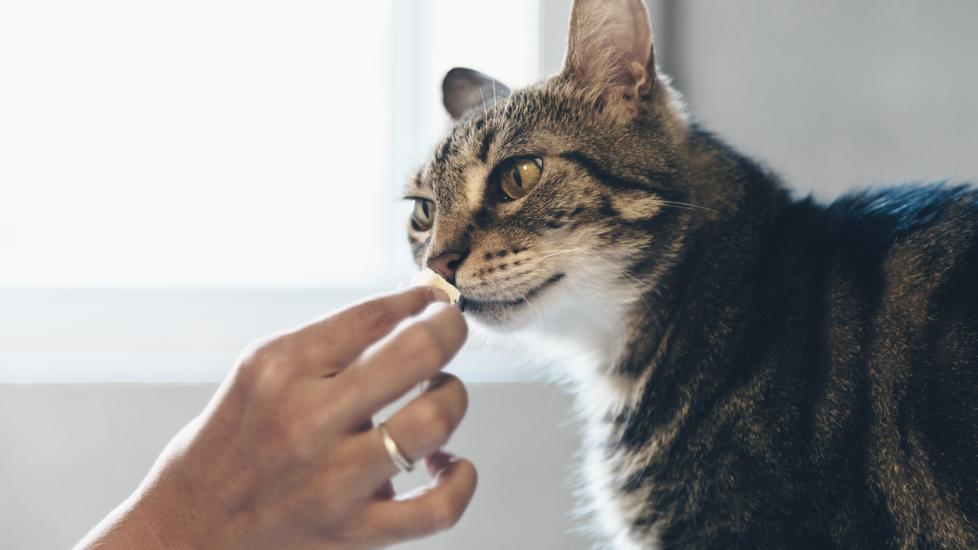Is It Safe to Use Dog Flea and Tick Products on Cats?
iStock/Sandra Milena Valero Orjuela
Fleas and ticks are parasites that can transmit diseases, cause discomfort, and quickly turn into a larger issue like a flea infestation in your home.
Since pets come in various sizes it may seem OK to use a dog flea and tick product on your cat, especially if you have both dogs and cats in your home.
But there are many factors, not only weight, that need to be considered before choosing the right flea and tick medication for your cat—and most importantly it can be dangerous and often lethal to use dog-specific flea and tick medicine on your cat.
Key Takeaways
- Ingredients in dog-specific flea and tick treatments can be toxic to cats and cause serious reactions.
- If you have a cat and a dog, make sure to monitor them after flea and tick treatment is applied topically to ensure your cat doesn’t lick it off your dog.
- Flea and tick medication poisoning in cats is extremely dangerous—if you believe your cat may have ingested or overdosed on flea and tick treatment, contact your veterinarian immediately.
Can You Use Dog Flea and Tick Treatments on Cats?
The main reason you should never give your cat a flea and tick medication formulated for a dog is due to permethrin (a common ingredient found in dog flea and tick products).
Permethrin is a type of insecticide that is a synthetic version of a pyrethrin—a naturally occurring substance in chrysanthemum flowers. You can also find flea and tick products that contain pyrethrin, and this causes a lot of confusion. Here are the facts:
-
When used correctly, pyrethrin can be safe for cats
-
Permethrin is never safe for cats and can even be fatal
Permethrin can be ingested or absorbed through the skin. It is a part of many products including:
-
Dog flea and tick medications including topical products and collars
-
Environmental flea and tick treatments, including liquids, powders, dusts, aerosols, and sprays
-
Some repellent-treated clothing (typically includes hiking, gardening, outdoor gear)
The best way to protect your cats is to avoid using permethrin-containing products entirely. If that isn’t possible, read the product’s label to determine how long you need to keep your cats away from treated areas and dogs (at the very least until the product is completely dry).
Symptoms of Flea and Tick Treatment Poisoning in Cats
Cats can be exposed to permethrin through oral, respiratory, and topical routes, including licking or grooming a companion dog that has been treated, walking through moist areas recently treated, or rubbing against surfaces where permethrins have recently been applied.
Signs of permethrin toxicity in cats may include:
-
Excessive salivation/drooling
-
Restlessness (anxious behaviors)
-
Lack of coordination (ataxia)
-
Tremors/muscle twitching
-
Abnormal breathing
If your cat gets into a flea and tick product that is made for dogs, seek veterinary care immediately.
Your veterinarian may be able to treat your cat on an outpatient basis, or hospitalization may be required. The prognosis depends on the severity of the exposure, the clinical signs your cat is displaying, and the response to treatment. The prognosis can range from good to poor; cats can die from permethrin toxicity.
Why Can’t Cats Use Dog Flea and Tick Medications?
There are two main reasons why cats should not use dog flea and tick medications.
Cats Respond Differently to Medication
Cats and dogs have important differences in their liver metabolism. This is the key reason permethrin can be used safely in dog flea and tick products, but are not used in cat flea and tick products.
Since a cat’s system cannot metabolize the chemical safely, there can be negative effects on many organ systems, leading to respiratory, nervous, and gastrointestinal complications and even death.
Size Matters
Your cat’s size is an important factor when determining the right dose for flea and tick medication. Medicine is not always distributed evenly throughout a pill or liquid.
Weigh your cat and use an appropriate cat-safe treatment or preventive for their weight range. Your veterinarian can help you get an accurate weight before determining an appropriate dosage.
But remember that the weight of the pet (cat or dog) is not the only factor in determining medicine dosage and absorption. Dogs and cats process drugs differently and formulations made for cats are based on their unique needs.
It’s also important to not give your dog flea and tick treatment manufactured for cats.
Flea and Tick Medications Safe for Cats and Dogs
There are several safe brands and formulations of flea and tick preventives and/or treatments for both cats and dogs. Below is a list of flea and tick medications labeled specifically for cats that are safe when used at the appropriate dose. Most of these products are also available for dogs and are a great option for treating dogs who live with cats.
Other medications you may consider include:
It’s important to find a flea and tick preventative that works for your cat, and to ensure their safety whenever introducing a new medication into their life. Always discuss a change in medication or any questions around flea and tick prevention with your veterinarian to determine the best option.
References
-
Toynton, K.; Luukinen, B.; Buhl, K.; Stone, D. National Pesticide Information Center. Permethirn Technical Fact Sheet. March 2009.
-
Gwaltney-Brant, S. Veterinary Information Network. Pyrethrin/Pyrethroid Toxicosis (Feline). January 2016.
